- 1. Start your moving preparations early
- 2. Measure your stuff and the pathway
- 3. Use the right lifting techniques, especially with heavy objects
- 4. Disassemble large furniture
- 5. Use furniture sliders
- 6. Invest in a hand truck or furniture dolly
- 7. Use lifting straps
- 8. Protect your floors and walls
- 9. Clear a path
- 10. Use ramps for steps
- 11. Slide items downstairs on moving blankets
- 12. Wrap furniture in padding or blankets
- 13. Create smooth surfaces on floors with cardboard
- 14. Recruit helpers
- 15. Take breaks
- Does renters insurance cover my heavy furniture during a move?
Moving heavy furniture can be a daunting and overwhelming task. Whether you’re relocating to a new home or simply trying to apply feng shui in your current home, the process requires careful preparation and physical labor.
Let’s dive into 15 best practices for how to move heavy furniture safely and efficiently.
1. Start your moving preparations early

Create a detailed moving checklist, as soon as you know you’re relocating, so you can break each task down into smaller, manageable steps and reduce last-minute rushing.
Preparing to move—especially if you’ll be moving heavy furniture on your own—probably takes more time and physical exertion than you think.
For example, a 2024 Lemonade-commissioned moving insights survey, that asked 2,000 Americans who have moved in the last five years how they approach and experience moving, found that almost half (48%) of respondents gave themselves only two weeks or less to pack before their most recent move. But 63% believe the packing process should ideally start more than three weeks before moving day.
The study also found that it takes the average American two months to bounce back physically after moving.
2. Measure your stuff and the pathway
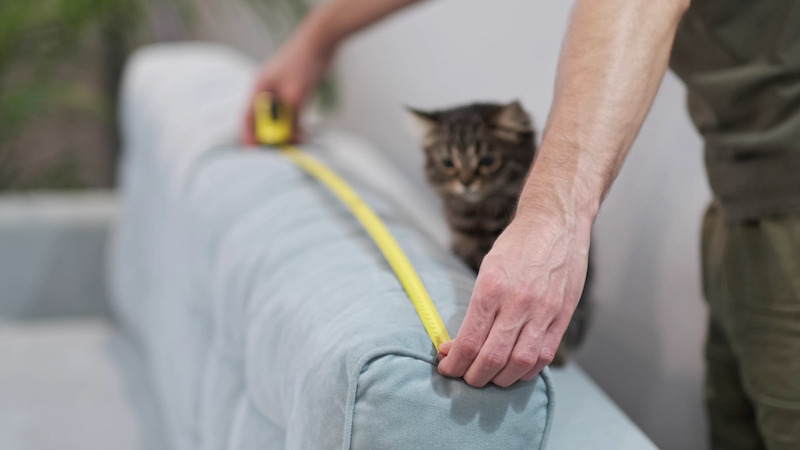
Make a detailed list of the items you need to move, including furniture, appliances, and personal belongings. Measure the dimensions of your furniture, and also measure the doorways, hallways, and staircases it needs to pass through. This will help you determine what will fit on moving day and identify any necessary adjustments.
3. Use the right lifting techniques, especially with heavy objects
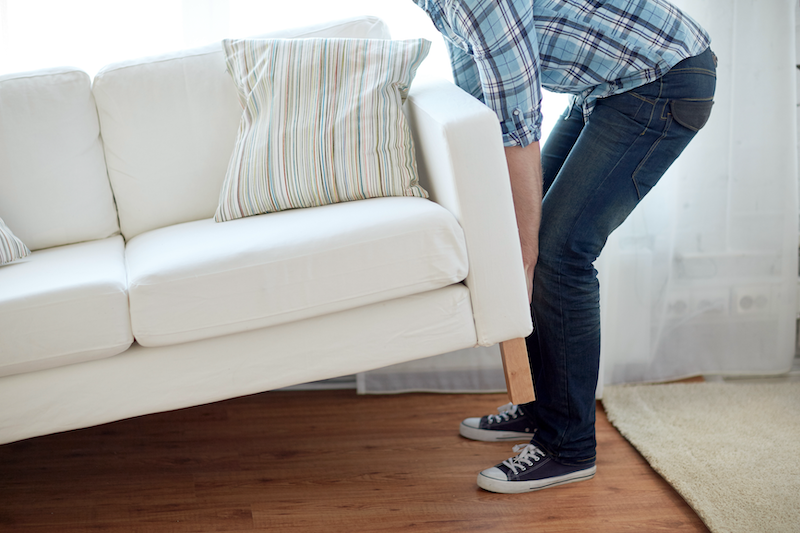
Incorrect lifting can result in severe injuries. Always bend at your knees, not your waist, and use your leg muscles to lift heavy items with your back straight. Keep the furniture close to your body to maintain balance and reduce strain on your back.
If an item is too heavy to lift on your own, ask for help. Team lifting with one or more people can distribute the weight and make the task more manageable. Remember, it’s better to take extra time and lift properly than to rush and risk injury.
4. Disassemble large furniture
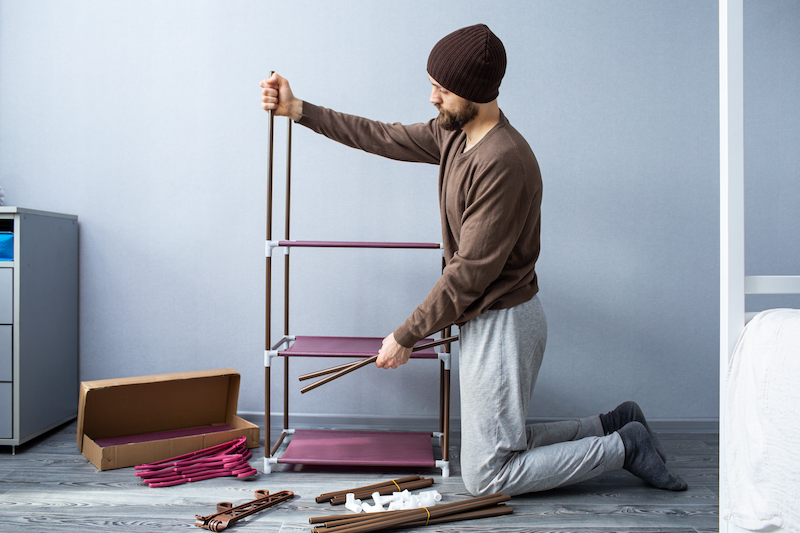
Whenever possible, disassemble large furniture pieces. Removal of legs, arms, or other detachable parts can make bulky items easier to maneuver through tight spaces. Keep all screws, bolts, and small parts in a labeled bag to make reassembly easier.
Disassembling your furniture not only makes it lighter and more manageable but also reduces the risk of damage during the move. It can be particularly helpful for items like bed frames, dining tables, and sectional sofas that often have removable parts.
5. Use furniture sliders
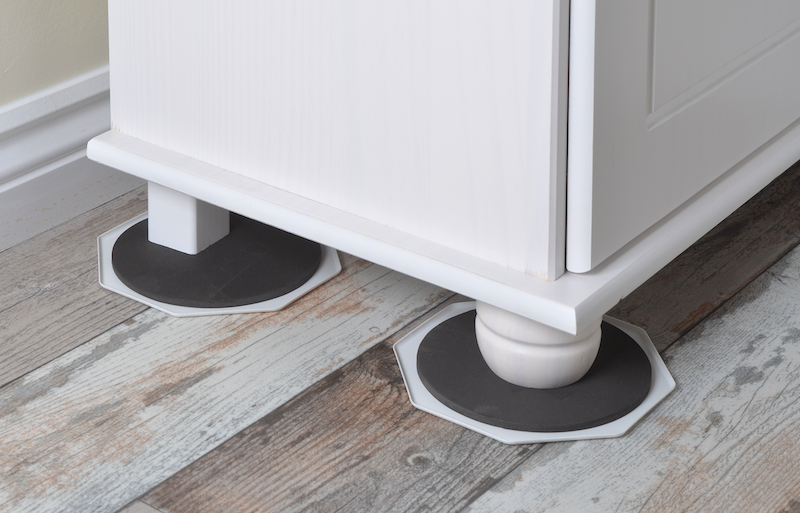
Furniture sliders are a game-changer when it comes to moving heavy items. These small disks can be placed under the legs or corners of your furniture, allowing you to glide the piece effortlessly across the floor without scratching it.
Sliders come in various materials suited for different flooring, such as carpet or hardwood. They reduce friction and make it possible to move even the heaviest items with minimal effort, saving you both time and energy.
6. Invest in a hand truck or furniture dolly
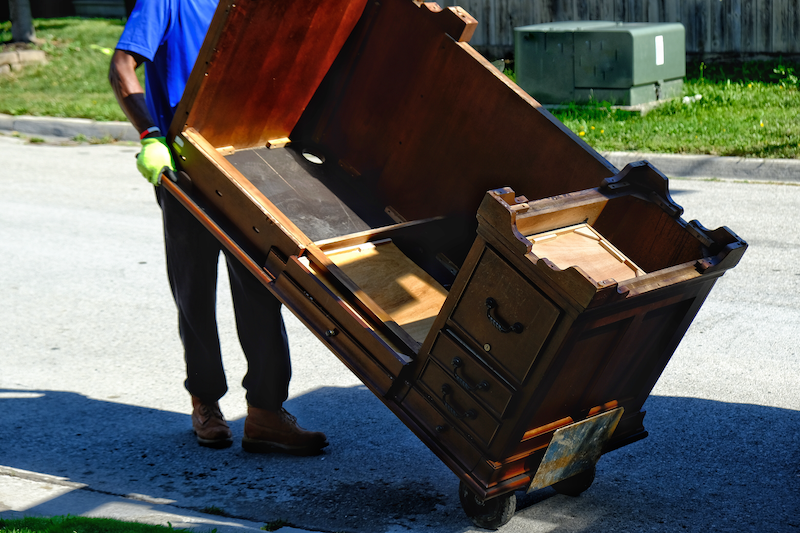
A hand truck or dolly can significantly reduce the physical effort required to move a heavy piece of furniture. These tools are designed to carry heavy loads, allowing you to wheel the furniture, rather than lift it.
Make sure the hand truck or dolly you choose has a sturdy construction and is rated for the weight of the items you need to move. These tools are especially useful for moving items like refrigerators, washing machines, and large boxes.
7. Use lifting straps
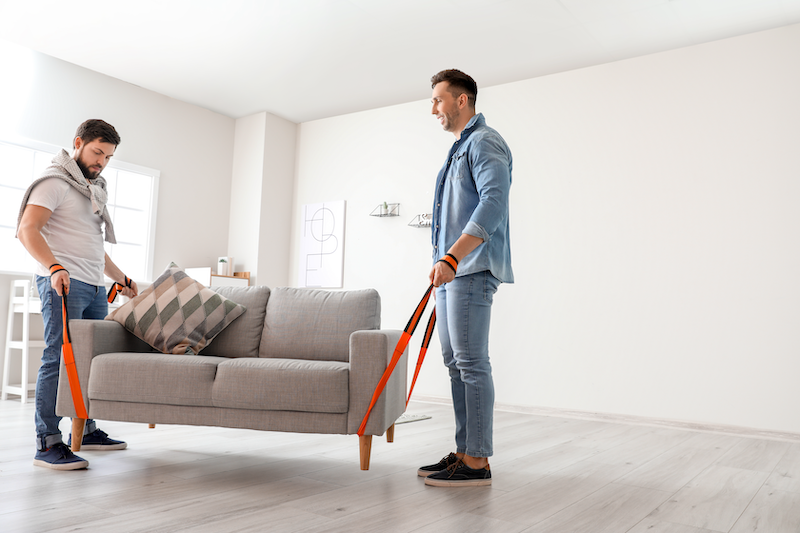
Lifting straps can help distribute the weight of heavy furniture more evenly, making it easier to lift and move. These straps offer better leverage and reduce the pressure on your back and arms.
When using lifting straps, ensure they are properly adjusted and securely fastened around the furniture. This will provide a safer and more efficient way to lift heavy items, especially when working with a partner.
8. Protect your floors and walls

Protecting your home during a move is crucial to avoid damage. Use blankets, cardboard, or foam padding to cover floors and walls. These protective materials act as a buffer and help prevent scratches, dents, and scuffs.
Pay special attention to corners and narrow doorways where damage is most likely to occur. Additionally, you can tape down protective materials to keep them in place as you move furniture.
9. Clear a path

Before you start moving heavy furniture, clear a path from the starting point to the destination. Remove all obstacles, such as rugs, decorative items, and small furniture pieces that could cause tripping or blockage.
Having a clear path not only makes the moving process quicker but also minimizes the risk of accidents. It ensures that you can focus on safely moving the heavy item without worrying about navigating around objects.
10. Use ramps for steps

If you need to move heavy furniture up or down steps, using a ramp can make the task easier—especially useful for navigating small sets of stairs. On average, portable ramps can be rented for roughly $50 to $150 a day, or weekly for about $150 to $450.
They can be set up quickly to create a smooth incline for wheeling items, and some rental companies also offer delivery and setup services for an additional fee.
11. Slide items downstairs on moving blankets
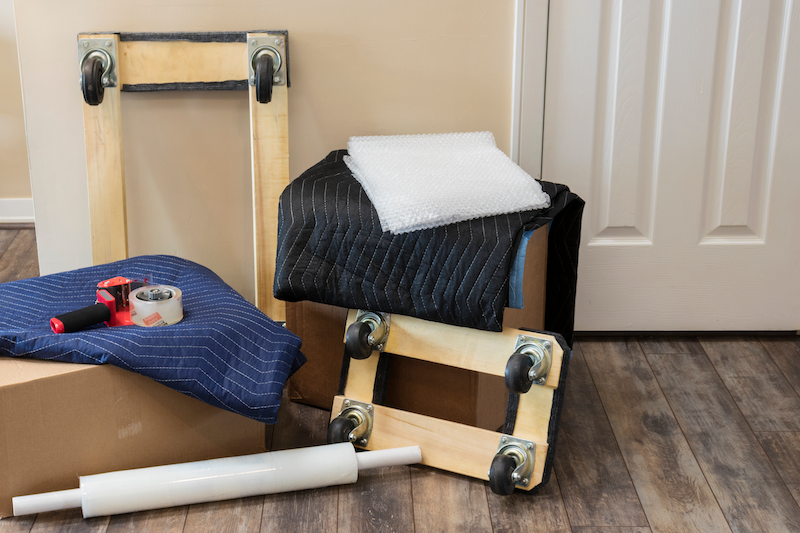
When you don’t have a ramp, a thick blanket can be a handy alternative for moving items downstairs with a few simple steps, including:
- Lay the blanket on the stairs
- Place the item on top
- Carefully slide it down, controlling the descent to avoid damage
This method requires two people: one to guide and control the item from above and another to support and slow the descent from below.
12. Wrap furniture in padding or blankets
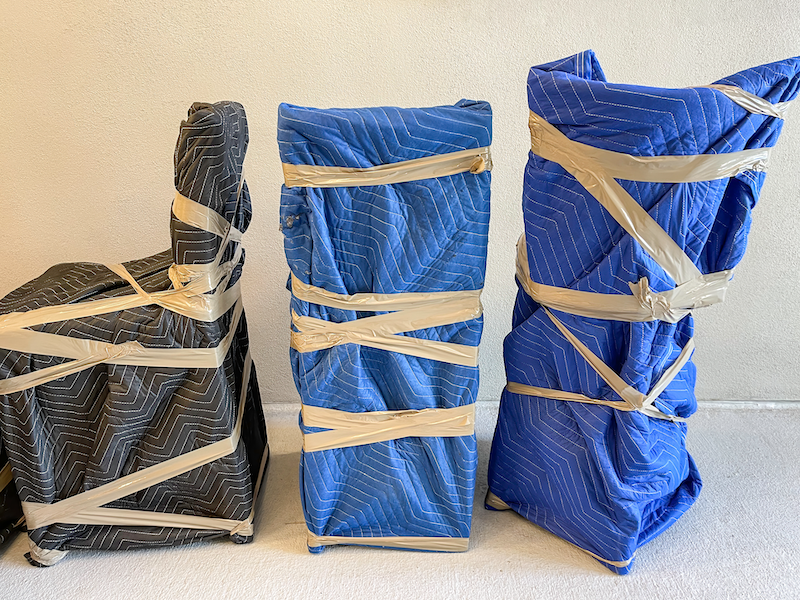
Padding your furniture with pads or blankets protects it from damage and makes it easier to slide across floors. Secure the padding with tape or rubber bands to prevent it from shifting during the move.
This technique is particularly useful for protecting delicate surfaces and edges of your furniture. It also provides an extra layer of protection for your floors, reducing the likelihood of scrapes and dents.
13. Create smooth surfaces on floors with cardboard

Getting creative with materials like cardboard can facilitate moving. Place pieces of cardboard on your floor to create a smooth surface over which you can slide heavy furniture, minimizing friction.
Cardboard is an affordable and readily available option that acts like a temporary pavement. It works well on both carpeted and hard floors, making it easier to shift heavy items with less effort.
14. Recruit helpers

Never hesitate to ask friends or family for help when moving heavy furniture. Having additional hands and strength makes the job faster and safer for everyone involved.
Coordinate with your helpers to ensure that everyone knows their role and the plan. Clear communication and teamwork can significantly ease the burden of moving heavy items, reducing the risk of injury.
15. Take breaks

While it might be tempting to get everything moved quickly, it’s important to take regular breaks. Resting helps prevent fatigue and reduces the risk of injury. Use the breaks to hydrate, stretch, and assess your progress—or to unwind a little.
Bonus tip: If it’s too much, consider professional movers
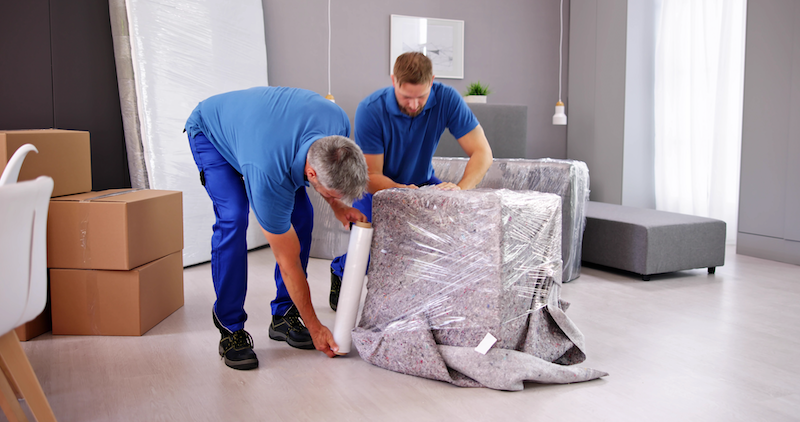
Sometimes the safest and most efficient option is to hire professional movers. They have the expertise, equipment, and manpower to handle heavy furniture without causing damage or injury.
Professional movers can take the stress out of the process, allowing you to focus on other aspects of your move. While it may be an additional expense, the peace of mind and reduced risk of injury often make it worth the investment.
Does renters insurance cover my heavy furniture during a move?
Yes. As you’re packing up your life and physically moving your belongings, the last thing you need is to worry about potential damages or losses, especially to your larger, higher-ticket items. That’s where renters insurance can come in handy.
Lemonade renters insurance policies will cover all the stuff you pack, including heavy furniture, as you move from point A and point B, so long as you’re the one doing the packing and moving. So if you’re packing and loading your own stuff en route to your next home, those policies will cover a range of damages.
Here are just a few scenarios where renters insurance coverage by Lemonade could come in handy when self moving:
Your stuff gets damaged or stolen in a storage unit during the transition
If you’re moving to a new apartment, and your Lemonade Renters policy on the address you’re moving out of is paid up and active through the end of a given month, it would help cover stuff you keep in a storage unit during that month.
So if you’re in the middle of a move to a new apartment, and decide to store your larger furniture—like your sectional sofa, bed, and dining room table—in a storage unit temporarily, it will be protected against potential risks like theft or damage while it’s in storage.
Someone vandalizes your belongings mid-move
Let’s say you’ve just moved your beautifully restored antique armoire outside, ready to load it into your car for the move to your new apartment. You step inside for a moment to grab another item, but when you return, you discover that someone has vandalized the armoire, leaving deep scratches and graffiti on its surface.
This kind of malicious damage is disheartening, but Lemonade insurance can help mitigate the frustration. Your policy would cover the cost of repairing or even replacing the vandalized armoire, ensuring that one person’s senseless act doesn’t ruin your move or your treasured furniture.
Someone gets injured at your place while helping you move
Picture this: You’re in the thick of moving day, and a good friend offers to help you carry your heavy sofa down the stairs. Unfortunately, while navigating a tricky corner, your friend loses their grip and twists their ankle badly.
Lemonade insurance coverage extends to instances in which someone gets hurt at your place in an accident—whether that means hospital bills or legal fees from a lawsuit. Medical Payments To Others coverage can help out if something happens at your place, while Personal Liability coverage can be a life saver if the accident is your fault.
Before we pack up and go…
Moving—especially when you have heavy furniture—can be stressful. But protecting your stuff with insurance, like coverage offered by Lemonade, is quick and simple. Click below to start your free quote.
And if you already have a renters insurance policy, make sure to transfer your insurance to your new address ahead of your move.
A few quick words, because we <3 our lawyers: This post is general in nature, and any statement in it doesn’t alter the terms, conditions, exclusions, or limitations of policies issued by Lemonade, which differ according to your state of residence. You’re encouraged to discuss your specific circumstances with your own professional advisors. The purpose of this post is merely to provide you with info and insights you can use to make such discussions more productive! Naturally, all comments by, or references to, third parties represent their own views, and Lemonade assumes no responsibility for them. Coverage and discounts may not be available in all states.




